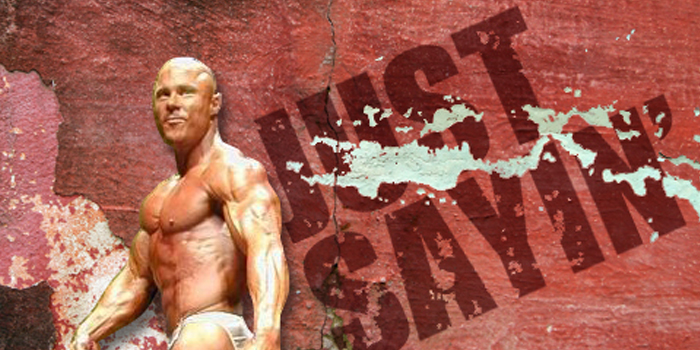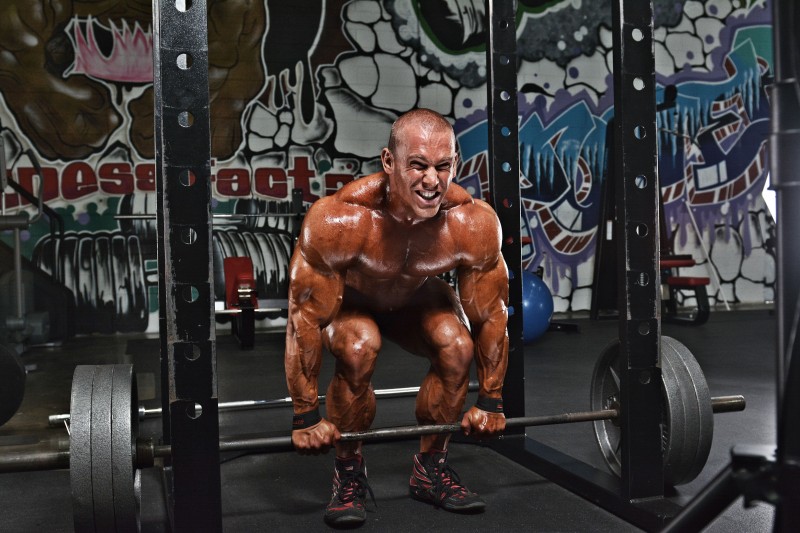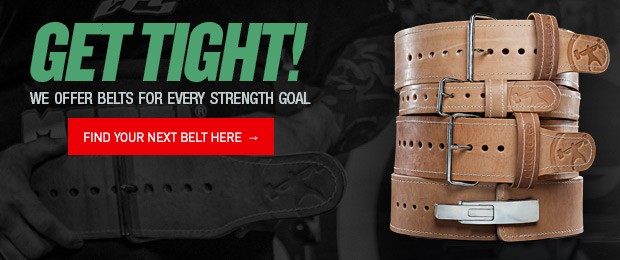
Yes, I am a glutton for punishment. I mean, who else in their right mind would have the Rice Krispies (read: old man balls) to spew such blasphemy on one of the top powerlifting sites on the internet?
I haven’t been hated on in a while, so let’s get to it. But first let’s establish something that I feel is quite important, yet I totally understand that anyone who disagrees with me won’t care about: I am referring to BODYBUILDING, not powerlifting. I get that this will matter to only a few of you and that I will be reminded that you have no idea how elitefts has managed to tolerate my idiocy for almost the last four years that I have written for them. If you can find it in your soul—your black soul—hear me out, and at least read this in its entirety. THEN you can post shitty comments about how retarded I am and that I don’t have any idea what I’m talking about.
There are bodybuilders with great back development that pull deads regularly. I am keenly aware of this, and I will agree completely with this statement.
RECENT: Body Mechanics 101: Elbow Position for Triceps Extension
There are bodybuilders with subpar back development that pull deads regularly. If you cannot agree with this statement, we can’t be friends.
I will concede that deads are not useless and that they will absolutely contribute to increased size and mass of primarily the erectors and traps (notice I said “primarily”). The question becomes this: What part do deads play in the overall development of the back musculature in relation to bodybuilding?
If you have weak erectors then deads might be a nice addition to your back-training protocol. If you want to push your strength up and the ability for your core (I like to use that word because it is typically hated by people who deadlift) to stabilize big weights for bent rows, squats, etc., then deads might be a nice addition as well.
However, deads do little to nothing for lat development. Those who focus on deads as their primary focus for back work will typically end up with weak back width and weak or underdeveloped lats.
Placement of deads in a bodybuilding routine (programming) also becomes an issue when they are placed first or early in a training session. If you are busting balls—and deadlifting should be ball-busting—you typically end up with very little in the tank to give to the exercises that follow deads. You know, the ones that actually contribute to overall back development as a bodybuilder. Good luck rowing through a full range of motion with heavy weights, and good luck even doing heavy lat work after pulling big weights for deads. Logic should dictate that if deads are a part of your workout, they should probably come after isolation work so that isolation work is not jeopardized and the back workout can be completed with deads for an almost “pre-exhaust” type of situation. Doing it this way, the deads push the fatigued muscles of the back even further after full range-of-motion isolation work (isolation relative to limited range-of-motion when doing deads).
Now is probably a good time to reiterate what I said earlier. Deads aren’t useless; they are just OVERRATED for bodybuilders.
I watched a couple guys in their late 20s last night at the gym pulling deads for numbers I have not ever pulled in my life, and yet their back development was not what mine is. I am sure I have trained longer than they have, yes, but you need to keep in mind that my back isn’t even that good — certainly not one of my better body parts for the last 25 years I have competed. I have pulled deads for maybe a combined total of five years of my over 30 years of training. And to answer the obvious question: No, my back did not improve when I was pulling deads.
Am I the only example? Hell no. And it is important to ask yourself, for those that do have good back development and pull deads all the time, did the back development come from deads (full back development) or was their back so genetically predisposed to great back development that they excelled at exercises like, let’s say, deads? More directly: Does Johnnie O Jackson have a great back because of deads or because he was so genetically predisposed to great back development that when his Momma said, “Go with your strengths” (as most mommas do), he did just that, and pulled deads for record poundages?
WATCH: Mountain Dog Back and Biceps with Mark Dugdale
Steve Kuclo started his bodybuilding career pulling deads and got away from them in later years for safety/injury reasons (potential risk vs. reward). Phil Heath, I doubt, has ever pulled a dead in his life. I say that because I knew him well and saw him train on a frequent basis from his younger bodybuilding years until he started winning Sandows. Not only does he have a great back, but he also brought it up from NOTHING without doing deads. Early on he was told repeatedly that he would never turn pro due to his weak back development, and look where he is now, without doing deads.
One more caveat to consider from a bodybuilding perspective: Very few people who pull deads for big weights have small, tapered waists. Before you scream and yell at me with your one or two examples, I said “very few.” There are always exceptions, but most guys who pull big numbers for years have a very thick and “untapered” midsection. Even if you were able to grow your back to the point where you added six inches of width, is that a fair trade if you add four inches to your midsection? I say no; you might disagree.
Listen, this isn’t a deflection. I would do deads if I could, simply for stabilization strength and support of my spine. I have terrible back/disc issues that don’t allow me to do them anymore — not even light. My issue with deads isn’t that they don’t work, but that they are overrated and too much emphasis is given to them for FULL back development. If you want to use them in your bodybuilding repertoire (I’m going full French today), at least put them later in your back workout, or even at the end, so that you can give 100% to the full range-of-motion exercises that will benefit your back development so much more.
And for those that simply read the title and don’t bother to read anything else before going straight to the comment section: You’re easy – just like your mom.
Xoxo, MUAH! Just Sayin’.
Image courtesy of Jeffrey Sygo












I never ever ever had calves that would grow. If you ever think of it, I would love an article on calves.
Thanks for the excellent read as usual!
Surely you wouldn't feel the same about RDLs for hamstring development?
I've really never understood why people say deads are a "back" exercise anyway. I mean they use a bit of everything obviously, but mostly quads then posterior chain surely?
Deads hammer the shit out of your back if performed properly. If your lats and overall back musculature from your traps down to your erectors aren't in excruciating pain, then you're not performing the Deadlift properly and using all of the muscles required to maximize the lift.
One must also consider that every BBer out there performs Deads with straps. Pulling with straps takes out the grip strength component which forces one to use more of their back muscles. You can get away with not being tight in the back in the starting position if using straps. If you want the Deadlift to build your back, DON'T USE STRAPS. PERIOD!
Skip is correct on the subject of FULL BACK development. Even when I was BBer style training, I'd save Deads until the end of the workout. Made em tougher and it was fun finishing back training with Deads.
Agree with you completely
Unfortunately, I am not one of lucky ones who built large traps or erectors from DLs. I use other exercises to train those muscles.
Rather than looking at the totality of Ronnie's training and giving credit where it was due, all the praise for his back development was bestowed on the deadlift. In reality, it was his ability to do 500 pound barbell rows, T-bar rows with a dozen plates, 300 pound one-arm dumbbell rows, etc...that contributed to the majority of his development in the lats, teres major & minor, rhomboids, infraspinatus, and supraspinatus muscles. Basically, the massive size of every muscle in his back, aside from his erectors and traps, were due to various forms of horizontal and vertical rowing (barbell rows, t-bar rows, pulldowns, etc). In other words...traditional back movements specifically designed to work those muscles through a full range of motion.
Prior to Ronnie, Dorian was known for having the best back development of all-time...and to this day, many still think Dorian's back, overall, was the best ever. regardless of where one strands on that subject, the point is that Dorian built his back without ever doing super heavy deadlifts. Dorian did do deads, but he never emphasized them when instructing others how to build their backs...and only used about 455 pounds for a moderate amount of reps (a relatively small amount of weight by today's standards). Dorian knew that deads, while useful, were not going to place maximum stress on the most important muscles of the back (from a bodybuilding standpoint) and therefore, he never prioritized them in his routine.
Now, with that said, I do think deads can be an important exercise...but primarily for the erectors and to a lesser degree, the traps (note: great traps can be built without ever doing a deadlift). I understand that some may disagree with me about not needing traditional full-range deads for maximal trap development. While I won't elaborate here, I stand by my opinion.
Now, where deads do shine is for erectors. I do NOT think one can maximize their erector development without doing some form of the deadlift...simply because no other type of exercise places so much stress on that muscles. Many see the erectors as nothing more than a "lower" back muscle, when in reality the erectors are a very large muscle. In fact, they are the largest muscle in the back--in terms of "square footage". They are very wide, running from the spine almost to the outer edges of each side of the back. They are also very long muscles, running from the pelvis all the way up to the base of the neck. They basically cover the majority of the back. However, we can't see most of this muscle, as it almost entirely covered up by the lats, rhomboids, and traps. We only see the bottom portion of this muscles, as it is clearly exposed to the eye.
The benefit of having this muscle maximally developed is that it will increase the thickness of the back along the entire length and width of of the spine, which is substantial. However, this type of thickness is reveals itself differently than most other muscles, simply because the bulk of the muscle isn't seen. It will push the lats, rhomboids, and traps out further, making the back appear to have more overall thickness, but it won't really make the lats, rhomboids, or traps themselves look thicker.
A good comparison is the brachialis muscle. Most of this muscle is also covered up, but instead of being covered by other back muscles, it is covered up by the biceps. We only see the small outer edge of this muscle on the outside of our arms--a little bump that sits right between the biceps and triceps. Despite it diminutive appearance, it is actually much larger than it looks,, contributing to a considerable portion of our upper-arm mass. As this muscles grows, it pushes the biceps up higher and higher, as it lies directly underneath the biceps. So, while it doesn't really make the bicep muscles themselves look any bigger or thicker, it does contribute to the overall height and circumference of the arm, making the entire upper-arm appear bigger in every pose.
The erectors play a similar role, as they add to the overall thickness and circumference of the back, but they won't actually make the lats or other muscles look more developed--maybe slightly so, but not much.
So, while the erectors certainly contribute to the overall size of our backs, they are of far lesser importance then muscles like the lats, teres muscle, rhomboids, traps, etc. A bodybuilder can have very weak erectors, but if all his other back muscles are maximally developed, he is going to have a fantastic back. On the other hand, a bodybuilder could have the best erectors in the world, but if all his other back muscles are weak, he is going to have very poor back development--in terms of both shape and size.
Because of this the erectors are of secondary importance, as they do not play nearly as large of a role in forming a championship back as the muscles which lay above them. Great erectors can give the back that extra bit of thickness and a great Christmas tree, but these are finishing touches...and pale in comparison to what the other back muscles bring to the table in terms of overall shape and size.
The bottom line is that the erectors are not nearly as important as the other back muscles...and the deadlifts are an inferior exercise for working those other muscles, as they do not take those muscles through a full range of motion. Rather, they act more as stabilizers, while the erectors and traps do the majority of the work.
So where does this leave us? There is no denying that having large erectors is better than having small erectors, but as Skip said earlier, what is the cost? Personally, I have yet to see someone who has worked up to pulling very heavy poundages (in the hypertrophy rep range) who did not simultaneously expand their waist to a significant degree. There are a lot of reasons why the deadlift does this, such as a thickening of the obliques and other midsection muscles, as well as a weakening/protrusion of the transverse abdominis, which can be caused through the repeated application of internal pressure to the transverse abdominis.
So, in my estimation, if one is seeking the most aesthetic back development possible, it might not be the best idea to maximally develop the erectors...as it is almost certainly going to lead to expansion of the waist line. However, we can't know in advance to what degree this might occur. That's why each indovodual needs to keep close tabs on his own physique and see how he responds. If he finds that his waist is starting to expand disproportionately to the rest of his physique, then it's time to back off...and maybe even take a break altogether.
I do think deads are a great exercise for beginners and intermediates, though, as the stabilization strength and overall foundation they provide will pay long-term dividends in multiple areas.
Also, sorry for my horrible grammar, spelling, etc, in the previous post. I just now re-read it and saw how many mistakes I made. I usually re-read things before posting, but I forgot this time around..
Size & condition (in combination with balance), truly rule the stage. While size and condition have always been important, they weren't always the overwhelming priorities they are today. Things like shape, lines, and the ability to display the physique (i.e. posing) used to matter a lot more than they do now. Back in the 70's, every bodybuilder strove to develop what they considered to be the "perfect" physique...not just the biggest physique. They would work on adding or even taking away size in very specific areas of the body if it meant improving their appearance according to the aesthetic standard after which they patterned themselves.
What a lot of guys don't seem to realize today is that each person's body has a predetermined amount of muscle it can hold without damaging its aesthetic appeal...and not just as a whole, but in terms of its individual parts. Not every muscle can be developed to the same degree. Depending on the person's genetics, they may nee to emphasize or de-emphasize certain areas of the body...and even certain sections of individual muscles, so that every part of the body fits together perfectly, thereby providing the best overall look that bodybuilder is capable of achieving.
This type of "sculpting"...this "art-form"...is nearly extinct.
The best back I ever seen belongs to a powerlifter from guyana, who lifted 780 pounds @ 182
And when sleeping the numbers are way higher than what one can do being awake.
Anyhoe.
Great article and I fully agree.
I guess the deadlift being necessary is as true as Jesus walking on water and bringing dead people back alive.
Only not being able to get himself off the cross.
Sorry if this sounded rude.. I think that Jesus was an intelligent man, with lots of wisdom.
But people tend to confuse reality with facts.
That goes for the deadlift for sure.
Risk is too high vs reward.